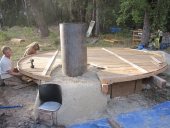
 6
6




 2
2




 4
4




Douglas Alpenstock wrote:The risk is possible, but it can be managed. For asbestos to cause harm it has to be drawn into the lungs as an aerosol or ingested into the digestive tract. If it's a wet blob of goo and you're wearing an industrial quality respirator, your risk is mighty low.
 4
4




 4
4




 3
3




 2
2




 4
4




 7
7




Country oriented nerd with primary interests in alternate energy in particular solar. Dabble in gardening, trees, cob, soil building and a host of others.
 7
7












 8
8




C. Letellier wrote:You do understand that many of the old red bricks were low fire and a low fire clay and can potentially disintegrate in a high temperature environment?
Proudly presenting RocketMassHeaters.com
A good starting point to all RMH research
How Permies.com works
 6
6




Benjamin Dinkel wrote:
I am very interested in your rocket oven design. What type oven are you building? I get a lot out of "sharing notes". You can check my latest out here.

|
You'll never get away with this you overconfident blob! The most you will ever get is this tiny ad:
The new purple deck of permaculture playing cards
https://www.kickstarter.com/projects/paulwheaton/garden-cards
|




